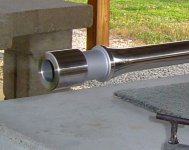So the “harmonic” frequency would be moving many times faster than the bullet. And also the bullets would be varying in speed. So how can they exit at the same “time.”
Just to clarify here, the vibrational frequencies(and there are many) and the resulting harmonic frequencies( and although fewer there are many of those too) do not have a velocity. There is an associated velocity, different for every frequency. But as you say, all of those faster than the bullet ... true but irrelevant. None of the frequencies 'exit' and tuning a rimfire has nothing to do with having the bullet exit coincident with any frequency exiting.There are many videos like the above showing no muzzle vibrations.
Even if tuners work, the amount shots required for a reasonable confidence level to determine the best setting is a lot more that what most of y'all are doing…. I think @stats_guy just dropped an app that will do these statistics.
The minute barrel movements that produce a positive compensation tune aren't going to be detected in a video of the sort presented.
The amount of shots required to determine an effective setting is astronomically large if the shooter does not understand how a tune works. For those that do, I think Lee's estimate is ballpark for many, I'm a little higher but then I've got a good tune applicable to a case or two more of that lot.


